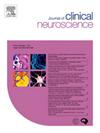Evaluating the safety and efficacy of proton radiotherapy for intracranial pediatric ependymomas: A single-arm meta-analysis
IF 1.9
4区 医学
Q3 CLINICAL NEUROLOGY
引用次数: 0
Abstract
Background
Ependymomas account for 6% to 10% of childhood central nervous system tumors. This study aimed to evaluate the safety and efficacy of proton radiotherapy in intracranial ependymoma patients.
Methods
We performed a systematic review and single-arm meta-analysis. We searched Medline, Embase, Cochrane, and Web of Science for eligible trials. Random-effects model was used to calculate the risk ratios (RRs), with 95% confidence intervals (CIs). Statistical analyses were performed using RStudio version 4.2.3.
Results
Ten cohorts comprising 908 patients with ependymoma were included. The patient population had an average age of 3.5 years, and 53.4 % were male. In terms of proportion, nine outcomes were analyzed: 3-year Progression-Free Survival (PFS; Proportion = 0.63; 95 % CI [0.40–0.87]; I2 = 95 %), 5-year Local Control (LC; Proportion = 0.79; 95 % CI [0.69–0.90]; I2 = 85 %), 5-year Event-Free Survival (EFS; Proportion = 0.65; 95 % CI [0.52–0.78]; I2 = 95 %), 5-year Overall Survival (OS; Proportion = 0.83; 95 % CI [0.77–0.90]; I2 = 82 %), 2-year OS (Proportion = 0.91; 95 % CI [0.88–0.94]; I2 = 0 %), 3-year OS (Proportion = 0.92; 95 % CI [0.89;0.95]; I2 = 43 %). Additionally, neurological (Proportion = 0.17; 95 % CI [0.07–0.27]; I2 = 97 %), dermatological (Proportion = 0.20; 95 % CI [0.00–0.44]; I2 = 82 %), and brainstem complications (Proportion = 0.03; 95 % CI [0.01–0.04]; I2 = 31 %) were investigated.
Conclusion
While proton radiotherapy appears safe and effective based on current data, these results should be approached cautiously, as broad confidence intervals in some adverse event rates suggest variability in outcomes.
评价质子放疗治疗颅内儿科室管膜瘤的安全性和有效性:单臂荟萃分析。
背景:室管膜瘤占儿童中枢神经系统肿瘤的6% ~ 10%。本研究旨在评价质子放疗治疗颅内室管膜瘤的安全性和有效性。方法:我们进行了系统回顾和单臂荟萃分析。我们检索了Medline、Embase、Cochrane和Web of Science来寻找符合条件的试验。采用随机效应模型计算风险比(rr),置信区间为95%。使用RStudio 4.2.3版本进行统计分析。结果:纳入10个队列,共908例室管膜瘤患者。患者平均年龄为3.5岁,男性占53.4%。就比例而言,分析了9个结果:3年无进展生存期(PFS);比例= 0.63;95% ci [0.40-0.87];I2 = 95%), 5年局部控制(LC;比例= 0.79;95% ci [0.69-0.90];I2 = 85%), 5年无事件生存率(EFS;比例= 0.65;95% ci [0.52-0.78];I2 = 95%), 5年总生存率(OS;比例= 0.83;95% ci [0.77-0.90];I2 = 82%), 2年OS(比例= 0.91;95% ci [0.88-0.94];I2 = 0%), 3年OS(比例= 0.92;95% ci [0.89;0.95];i2 = 43%)。此外,神经系统(比例= 0.17;95% ci [0.07-0.27];I2 = 97%),皮肤病学(比例= 0.20;95% ci [0.00-0.44];I2 = 82%),脑干并发症(比例= 0.03;95% ci [0.01-0.04];I2 = 31%)。结论:虽然根据目前的数据,质子放疗似乎是安全有效的,但这些结果应该谨慎对待,因为一些不良事件发生率的广泛置信区间表明结果存在差异。
本文章由计算机程序翻译,如有差异,请以英文原文为准。
求助全文
约1分钟内获得全文
求助全文
来源期刊

Journal of Clinical Neuroscience
医学-临床神经学
CiteScore
4.50
自引率
0.00%
发文量
402
审稿时长
40 days
期刊介绍:
This International journal, Journal of Clinical Neuroscience, publishes articles on clinical neurosurgery and neurology and the related neurosciences such as neuro-pathology, neuro-radiology, neuro-ophthalmology and neuro-physiology.
The journal has a broad International perspective, and emphasises the advances occurring in Asia, the Pacific Rim region, Europe and North America. The Journal acts as a focus for publication of major clinical and laboratory research, as well as publishing solicited manuscripts on specific subjects from experts, case reports and other information of interest to clinicians working in the clinical neurosciences.
 求助内容:
求助内容: 应助结果提醒方式:
应助结果提醒方式:


